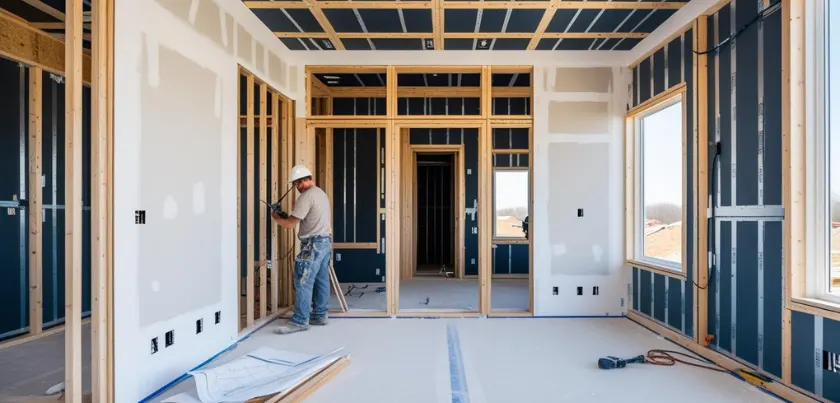Smart Home Integration During Residential Construction

Imagine controlling your lights, fans, appliances, CCTV cameras, and security systems with a single app or voice command. That’s the power of a smart home. Integrating home automation systems during the construction phase rather than retrofitting later ensures seamless installation, future readiness, and long-term savings. At Shree Constructions & Interior, we plan your home’s automation needs right from the design stage. In this blog, understand why smart home integration during residential construction is essential, its benefits, and how to plan it effectively.
What is Smart Home Integration?
Smart home integration means connecting your electrical devices, lighting, security systems, and appliances to a central controller that can be operated via:
- Smartphone apps
- Voice assistants (Alexa, Google Home, Siri)
- Remote controls or automated timers
From smart lighting and security cameras to automated curtains and AC controls, smart homes enhance convenience, safety, and energy efficiency.
Why Plan Smart Home Integration During Construction?
Here’s why planning automation during construction is better than retrofitting later:
A. Seamless Wiring and Installation
- Concealed wiring for smart switches, motion sensors, CCTV, and home theatres without damaging walls later
- Avoids exposed conduits or costly post-construction modifications
B. Cost Efficiency
- Cheaper to lay extra conduits and provision boxes during construction
- Saves on rework labour and material costs in future upgrades
C. Structural Readiness
- Beam and column placement can accommodate ceiling speakers, projectors, or motorised blinds
- Space planning for automation panels and servers is easier
D. Future-Proofing Your Home
- As technology upgrades, pre-planned homes are easier to upgrade without structural changes
- Adds resale value as modern buyers prefer ready smart home setups
Key Smart Home Systems to Plan During Construction
At Shree Constructions & Interior, we integrate the following smart systems during construction:
1. Smart Lighting
- Dimmable LED lighting controlled via app
- Motion sensor lights for bathrooms, driveways, or staircases
- Automated ambient lighting scenes for living rooms and bedrooms
2. Security Systems
- CCTV camera wiring and mounting points
- Video door phones with app integration
- Smart locks for main doors and gates
3. Climate Control
- Smart thermostats for AC and geyser control
- Integrated HVAC systems for large homes
4. Audio-Visual Systems
- Concealed wiring for home theatre setups
- Ceiling or wall-mounted smart speakers
- Network cabling for IPTV or streaming devices
5. Curtain and Blinds Automation
- Provision for motorised curtains or blinds
- Integration with sunrise-sunset timers or voice control
6. Energy Monitoring
- Smart meters to monitor energy consumption
- Automated switching for energy-saving appliances
Planning Smart Home Integration: Step by Step
Step 1: Identify Lifestyle Requirements
Discuss with your architect and automation expert:
- Rooms needing smart controls
- Entertainment needs (home theatres, multi-room audio)
- Security priorities (gate automation, CCTV)
- Budget for automation
Step 2: Choose Compatible Systems
Select brands and devices compatible with each other. Popular ecosystems include:
- Amazon Alexa compatible devices
- Google Home compatible devices
- Apple HomeKit devices
Tip: Avoid multiple standalone devices from different brands for seamless control.
Step 3: Design Wiring Layout
At the construction blueprint stage:
- Plan additional conduits and back boxes for smart switches
- Allocate space for control panels, routers, and servers
- Plan electrical load accordingly for automated devices
Step 4: Ensure Robust Internet Connectivity
Most smart devices operate over Wi-Fi or LAN:
- Plan for Wi-Fi routers and repeaters for full-home coverage
- Use Cat6 or higher cables for wired connections in heavy-use areas (home office, media rooms)
Step 5: Integrate with Structural Design
- Conceal ceiling speaker wiring within RCC slab design
- Provide power supply points for CCTV at optimal heights
- Allocate niches or cabinets for control hubs and battery backups
Step 6: Testing and Handover
Once electrical works are complete, smart devices are installed and configured before handover for seamless functionality.
Cost of Smart Home Integration in India (2025)
| Automation Type | Approx. Cost (₹) |
|---|---|
| Basic lighting automation | ₹1.5 – ₹3 lakh |
| Complete 2-3 BHK integration | ₹4 – ₹8 lakh |
| Luxury villas (full integration) | ₹10 lakh upwards |
Note: Costs depend on brand, features, and system scalability.
Benefits of Smart Home Integration
- Convenience: Control everything from your phone
- Security: Real-time monitoring and smart locks
- Energy efficiency: Save electricity with automated timers and sensors
- Luxury: Adds modern comfort to your lifestyle
- Resale value: Smart homes attract better market value
How Shree Constructions & Interior Ensures Smart Home Readiness
At Shree Constructions & Interior, we:
- Coordinate with architects, electrical consultants, and automation experts from the planning stage
- Design detailed wiring layouts for concealed installations
- Use only certified electricians and trained technicians for installation
- Test and train homeowners in using all smart home features
Final Thoughts
Smart home integration during construction is an investment towards your future-ready, secure, and efficient lifestyle. It enhances comfort and adds significant value to your property in today’s modern market.
Ready to Build Your Smart Home?
Contact Shree Constructions & Interior today for:
- End-to-end smart home planning and installation
- Integration with your construction project seamlessly
- Building homes that are beautiful, safe, and future-ready
Contact Shree Constructions & Interior Today!
Company Name: Shree Constructions & Interior
Company Address: 215, Ground Floor, Pocket 2, Block F, Sector 16, Rohini, Delhi, 110089
Company Phone No: +91-9355482982
